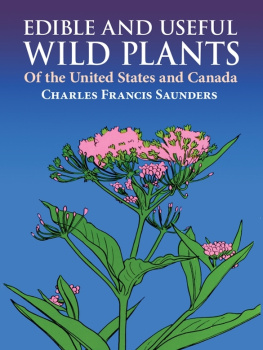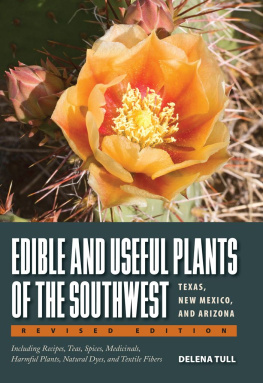
To buy books in quantity for corporate use or incentives, call (800) 962-0973 or e-mail premiums@GlobePequot.com.

Copyright 2013 Morris Book Publishing, LLC
ALL RIGHTS RESERVED. No part of this book may be reproduced or transmitted in any form by any means, electronic or mechanical, including photocopying and recording, or by any information storage and retrieval system, except as may be expressly permitted in writing from the publisher. Requests for permission should be addressed to Globe Pequot Press, Attn: Rights and Permissions Department, PO Box 480, Guilford, CT 06437.
FalconGuides is an imprint of Globe Pequot Press.
Falcon, FalconGuides, and Outfit Your Mind are registered trademarks of Morris Book Publishing LLC.
Photos: Jim Meuninck, except beargrass, page 85, licensed by Shutterstock
Text design: Sheryl P. Kober
Layout: Mary Ballachino
Project editor: Julie Marsh
Library of Congress Cataloging-in-Publication Data is available on file.
ISBN 978-0-7627-8469-1
Printed in the United States of America
10 9 8 7 6 5 4 3 2 1
The identification, selection, and processing of any wild plant for use as food requires reasonable care and attention to details since, as indicated in the text, certain parts are wholly unsuitable for use and, in some instances, are even toxic. Because attempts to use any wild plants for food depend on various factors controllable only by the reader, the author and Globe Pequot Press assume no liability for personal accident, illness, or death related to these activities.
ACKNOWLEDGMENTS
Feeling fortunate to have found this planet, I acknowledge it as my home and promise to keep it clean, tread lightly on its floor, and thank it daily for all blessings bestowed. I beg it to forgive my mistakes, ill manners, and careless recklessness. And when each of my given days is complete, I promise to sit quiet and listen to the earth sing, feel the air move, and revere all the green glory that is only found here.
But plants don't write, edit, lay out, and produce books. That job went to Jessica Haberman, Imee Curiel, Julie Marsh, Sheryl Kober, and the entire staff at GPP/FalconGuides. And yes, John Kit, who helped me find the elusive persimmon. Without your help, the plants described herein would not get their due. Your kind, patient, and trusting approach coaxed these words from me, and your insightful and imaginative creation forged them into a desirable and helpful tool for aspiring foragers. Thank you!
INTRODUCTION
Plants came first: They are the magic wand of Godwith them, with the firmament that supports them, we are possible. We eat plants, or eat animals that eat plants; therefore from plant chemistry came our skin and bones, blood and muscle. They are our food and medicine. In addition, they provide all the natural beauty, ambience, and culinary delights of a good life. They are the stuff of gardens and arboretums, forests and prairies, and mountain trails, and personally they have given this average, ordinary man a lifetime of entertainmentsuch simple pleasures, all free and described in the pages that follow.
Read thoroughly the Foraging Rules listed below. Follow these instructions and memorize the poisonous plants listed in the appendix. Although this information does not guarantee immunity from allergic reactions, it does provide basic protection against potentially toxic mistakes. The Forager's Dozen chapter presents twelve of my favorite wild plant foods, most of which can be found from coast to coast. Forager's Dozen Mushrooms is a novel chapter, an introduction to twelve easy-to-identify mushrooms that will add hours of pleasure while hiking and numerous culinary delights for your table. Yards, Gardens, Prairies, and Meadows is a collection of edible weeds and edible wildflowers found coast to coast in these environmentsmany of the best edibles come from this collection. Fruit and Berries, the next chapter, is a one-stop collection of fruiting vines, shrubs, and trees. If it's a fruit or berry you are looking at, go here. The Wetlands chapter covers edible plants found along streams and rivers, lakes, and ponds. Edible Plants of Eastern Forested Areas provides a clutch of flowering plants found typically in hardwood forests. Trees and Nuts is a coast-to-coast look at shrubs and trees that produce nuts. Edible Wild Plants of the Mountain West specifies plants found in the national parks and wilderness sanctuaries of Wyoming, Montana, Idaho, Utah, Oregon, and Washington. Edible Plants of the Desert describes food from extremely dry environments. And Marine Vegetables provides pictures and insights specific to edible marine and tidal area wild plant foods. Information on poisonous plants can be found in the appendix.
Read this book from cover to cover. Use it in the field and at home. Cross-check different chapters, as there are close relatives of several plants found in different environments. Start with the Forager's Dozen, identify these plants, and then progress to the Yards, Gardens, Prairies, and Meadows chapter, which covers numerous familiar plants. As you forage through different environments, match the environment to its corresponding chapter and build your repertoire of wild foods.
Carry this book next to your heart or on your hip when venturing forth seeking delectable wild treasures to grace your table and serve to your friends. Many recipes are described here to excite you, but your unique personal discoveries will soon humble what I know. So think freely, my friend, invent and conceivepass through this door of infinite possibilities and let your creative energy run wild.
WILD PLANT FORAGING RULES
It's a good idea to watch a plant through its growth cycle before eating it. This is helpful because many wild plants taste best just as they break through the ground, when they are small, furled, and difficult to identify. By watching them grow for a year, you will know what you are looking for in every season and where to find it.
Before eating any wild plants, study with an expert or take the plant to an expert for positive identification. Always cross-reference with two or more field guides. Make certain you have seen color photos of the plants; black-and-white photos or illustrations are not sufficient for positive identification.
After positive identification of an edible plant, taste only a very small amount of it. This precaution protects you from an allergic reaction or ill effects caused by misidentification.
Beware of the carrot family: Hemlock, water hemlock, and other members of this family are extremely poisonous. Learn to distinguish hemlock and water hemlock from elder (elderberries).
Practice conservation. Never collect more plants than you intend to use. Do not pick rare or endangered species. Work to restore wild plants from areas where they have disappeared. Do not plant alien or invasive species in your gardencheck with your state's cooperative extension services for details.
Avoid harvesting plants from polluted ground. Plants growing along roads are tainted with benzene, lead, oil, and other auto pollutants. Plants dwelling in streams and along fields near farms are polluted with herbicides and pesticides. Forage carefully. Droppings from wild game may spread bacteria, viruses, worms, giardia, amoebas, and other forms of contamination into water that nurtures edible wild plants. Wash and cook all plants foraged from wild lands.





